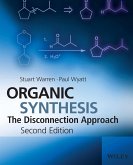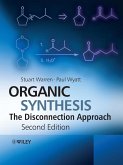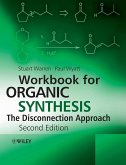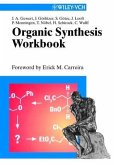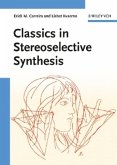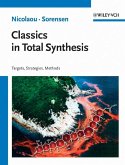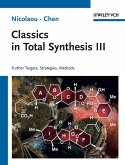Organic Synthesis: Strategy and Control is a sequel to Stuart Warren's bestseller Organic Synthesis: The Disconnection Approach. The 'Disconnection' book concentrated on the planning behind the synthesis of compounds.
The two themes of this new book are strategy and control: solving problems either by finding an alternative strategy or by controlling any established strategy to make it work.
The book is divided into five sections that deal with selectivity, carbon-carbon single bonds, carbon-carbon double bonds, stereochemistry and functional group strategy. Interpenetrating this structure, the 36 chapters start with classic methods and progress to modern methods and modern strategic considerations. Heterocyclic chemistry is treated throughout the book with full mechanistic explanations as part of organic chemistry rather than a separate mystery.
- A comprehensive, practical account of the key concepts involved in synthesising compounds.
- Takes a mechanistic approach, which explains reactions and gives guidelines on how reactions might behave in different situations.
- Focuses on reactions that really work rather than those with limited application.
- Extensive, up-to-date references in each chapter.
Students and professional chemists familiar with Organic Synthesis: The Disconnection Approach will enjoy the leap into a book designed for chemists at the coalface of organic synthesis.
In diesem Band geht es um zwei grundlegende Ansätze zur Lösung von Problemen in der organischen Synthesechemie: die Suche nach einer alternativen Strategie und die gezielte Modifikation eines existierenden Verfahrens. In fünf Hauptabschnitten widmen sich die Autoren selektiven Synthesen, der Kohlenstoff-Kohlenstoff-Einfach- bzw. Doppelbindung, der Stereochemie und funktionellen Gruppen. Jedes einzelne der insgesamt 36 Kapitel stellt dabei zunächst klassische Verfahren vor und leitet dann zu modernen Synthesewegen und Strategien über. Die Chemie der Heterocyclen wird in integrierter Form behandelt, ergänzt durch ausführliche mechanistische Erläuterungen. Im Wesentlichen beschränken sich die Autoren auf gut verifizierte, in verschiedensten Situationen funktionierende Vorschriften. Mit zahlreichen aktuellen Literaturverweisen!
Hinweis: Dieser Artikel kann nur an eine deutsche Lieferadresse ausgeliefert werden.
The two themes of this new book are strategy and control: solving problems either by finding an alternative strategy or by controlling any established strategy to make it work.
The book is divided into five sections that deal with selectivity, carbon-carbon single bonds, carbon-carbon double bonds, stereochemistry and functional group strategy. Interpenetrating this structure, the 36 chapters start with classic methods and progress to modern methods and modern strategic considerations. Heterocyclic chemistry is treated throughout the book with full mechanistic explanations as part of organic chemistry rather than a separate mystery.
- A comprehensive, practical account of the key concepts involved in synthesising compounds.
- Takes a mechanistic approach, which explains reactions and gives guidelines on how reactions might behave in different situations.
- Focuses on reactions that really work rather than those with limited application.
- Extensive, up-to-date references in each chapter.
Students and professional chemists familiar with Organic Synthesis: The Disconnection Approach will enjoy the leap into a book designed for chemists at the coalface of organic synthesis.
In diesem Band geht es um zwei grundlegende Ansätze zur Lösung von Problemen in der organischen Synthesechemie: die Suche nach einer alternativen Strategie und die gezielte Modifikation eines existierenden Verfahrens. In fünf Hauptabschnitten widmen sich die Autoren selektiven Synthesen, der Kohlenstoff-Kohlenstoff-Einfach- bzw. Doppelbindung, der Stereochemie und funktionellen Gruppen. Jedes einzelne der insgesamt 36 Kapitel stellt dabei zunächst klassische Verfahren vor und leitet dann zu modernen Synthesewegen und Strategien über. Die Chemie der Heterocyclen wird in integrierter Form behandelt, ergänzt durch ausführliche mechanistische Erläuterungen. Im Wesentlichen beschränken sich die Autoren auf gut verifizierte, in verschiedensten Situationen funktionierende Vorschriften. Mit zahlreichen aktuellen Literaturverweisen!
Hinweis: Dieser Artikel kann nur an eine deutsche Lieferadresse ausgeliefert werden.
This is a book which will change the way you think about making molecules. (Chemistry World, July 2008)
The authors can be commended on producing a really useful and enjoyable new book on Organic Synthesis. (Reviews, June 2008)
"The authors have spent approximately ten years putting this excellent book together, and their hard work has paid off." (Journal of Chemical Education, May 2008)
"Of interest to the experienced practitioner looking to broaden (or reawaken) awareness of the remarkable diversity of available synthetic transformations"(Journal of Medicinal Chemistry, 2008)
The authors can be commended on producing a really useful and enjoyable new book on Organic Synthesis. (Reviews, June 2008)
"The authors have spent approximately ten years putting this excellent book together, and their hard work has paid off." (Journal of Chemical Education, May 2008)
"Of interest to the experienced practitioner looking to broaden (or reawaken) awareness of the remarkable diversity of available synthetic transformations"(Journal of Medicinal Chemistry, 2008)



